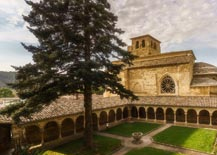
Locality: ESTELLA (31200)
Address: Calle San Nicolás, 1
Zone: The Central Zone
Style: Romanesque
Centuries of construction: XII
Description
On the Pilgrim’s Way to Santiago, in the centre of the old mediaeval city of Estella, stands the church of San Pedro de la Rúa, the largest church in the city whose 12th-century cloister is considered to be one of the most valuable in terms of Romanesque sculptural richness in Navarre.
Opposite the Palace of the Kings of Navarre on high ground overlooking the city, this church also reveals a beautiful 18th-century porch with lobed arches, reflecting the Arab influence, and rich ornamentation, an imposing tower and an interior that houses, among other things, the Romanesque stonework of the chorus and a number of interesting Romanesque and Gothic sculptures.
Its location on the side of a steep slope on which the first castle in Estella was built determined the irregular layout of the church. During the Middle Ages it was used as a pilgrims’ cemetery. In the 13th century the Bishop of Patras (Greece), San Andrés (St Andrew), was buried here, and his reliquary is venerated in the church.
The cloister
The cloister, built around 1170, is one of the most beautiful parts of the church. It only conserves the north and west galleries, because the other two disappeared with the destruction of the castle of Zalatambor (ordered by King Felipe II in 1572). With a square layout, it belongs to the decorative late Romanesque period, which combines the iconography of the Pilgrim’s Way to Santiago with other plant and animal motifs.
It has simple semicircular arches, nine on each side, that are supported by pairs of columns. The capitals in the north wing represent scenes of the Saints and the life of Christ, while those in the west passage contain motifs of plants and fantastic creatures such as harpies and variations on eagles. Do not miss an exceptional ‘folly’ in this last passage, which is repeated in Burgo de Osma and Santo Domingo de Silos: four twisted columns supporting the central set of arches.
Romanesque façade
Another valuable element of the church is its Romanesque façade from the early 12th century, which has a series of lobulated arches (Arab influence) and rich ornamentation. It has some similarities with the façades of the churches of Santiago (in Puente la Reina) and San Román (Cirauqui).
Its solid and imposing rectangular at the foot of the nave gives the complex a military appearance, reinforced by the arrow slits. The different phases of construction are excellently shown in this tower, whose final brick section dates from the 17th century.
Inside
Inside the church is the chapel of San Andrés (1596), covered by a dome built in 1699 and decorated with Baroque plasterwork. The 17th-century Baroque altarpiece in the nave of the Gospel contains a 13th-century crucifix that, according to tradition, a Jewish enemy of the Christians threw into the river Ega. Miraculously, the image came back upriver until it reached the parish church of the Santo Sepulcro (Holy Sepulchre), where it was picked up.
Other artistic treasure inside the church, specifically in the vestry, are the Romanesque Virgin Mary of Belén (Bethlehem), a 14th-century Gothic crucifix, a carving of San Pedro (St Peter) from 1687 and a 13th-century baptismal font at whose base the Tree of Life is represented.
After the visit, take a rest on the steps leading up to the church and enjoy the view over the Romanesque Palace of the Kings, now home to the ‘Gustavo de Maeztu’ Museum. These steps were designed by Francisco Pons Sorrolla and built in 1966, at the same time that the Plaza de San Martín (next to the Palace) was urbanised.







